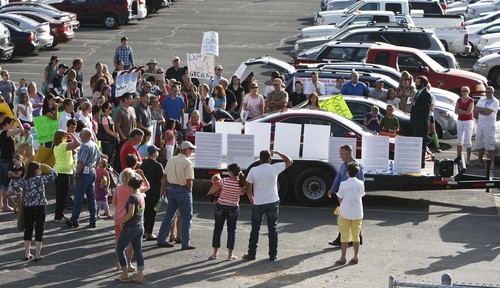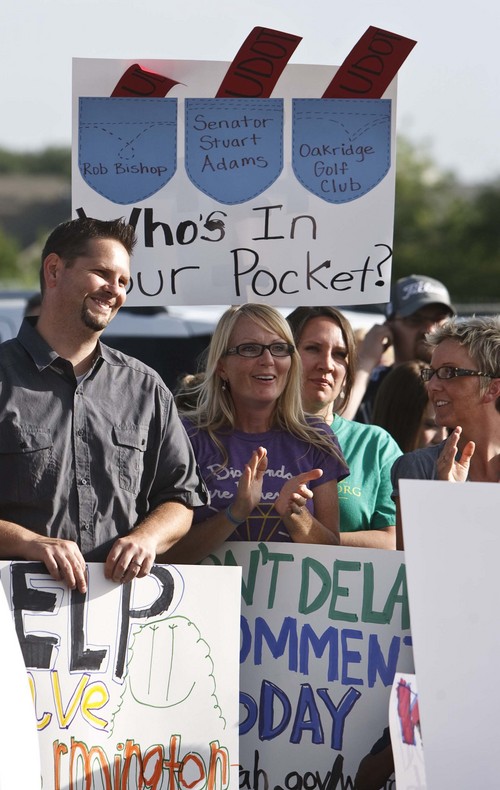This is an archived article that was published on sltrib.com in 2013, and information in the article may be outdated. It is provided only for personal research purposes and may not be reprinted.
The West Davis Corridor freeway — the proposed northern extension of Legacy Parkway — could be in deep trouble.
The U.S. Army Corps of Engineers is threatening to deny permits needed for the preferred route, saying it would destroy too many Great Salt Lake wetlands.
Federal law allows the corps to permit only the least damaging alternative route that is practical, and the agency recommends the state give serious consideration to what highway critics call the "shared solution" to avoid building a freeway entirely by improving existing roads and adding more mass transit.
"We believe the Locally Preferred Alternative does not represent the least environmentally damaging practicable alternative," the corps wrote to the Utah Department of Transportation.
UDOT's preferred route — which would begin at Glover Lane in Farmington — "has the most acres of direct and indirect" impacts to wetlands of all finalist alternatives studied, the corps said.
While it says another finalist alternative to begin the freeway at Shepard Lane is better, the corps really would like UDOT to take a serious look at the no-new-highway option.
—
Changes or delays? • Randy Jefferies, UDOT manager of the project, said the corps' objections "may lead to changes in the alternatives, the recommendations, the mitigation or the analysis" in studies for the freeway. He said he is unsure what sort of delays it could bring to UDOT's goal of making a final decision on a route by next year.
Opponents were more blunt in their assessment.
"UDOT will have to go back to square one and reassess its plans for this unnecessary freeway," said Steve Erickson, spokesman for the Shared Solution Coalition of community and environmental groups that has opposed the project.
The freeway would be the northwest extension of the Legacy Parkway — which itself was built after a four-year legal battle over damage it could do to wetlands. Compromise resulted in a parkway that has a reduced speed limit, special sound-muffling pavement, a ban on trucks and extensive areas of preserved wetlands, open space and a trail system.
UDOT posted online Friday more than 1,600 comments it received about the draft environment impact statement on the freeway during a comment period that ended earlier this month. The Army Corps of Engineers is the only one of those commentators with authority over permits required for the project.
—
Shrinking habitat • The letter from Jason Gipson, chief of the Corps' Nevada-Utah Regulatory Branch, noted that the Great Salt Lake wetlands are an internationally important stopover for 5 million migratory birds. He said those wetlands "have been extensively altered during the past century to the degree that very few undisturbed habitats remain."
The corps added, "We believe this underscores the importance" for UDOT to avoid and minimize "further impacts to the portions of the GSL ecosystem that remain rather than using these facts to justify focusing on avoiding impacts to the built environment."
But UDOT proposed choosing the Glovers Lane option over Shepard Lane in part because that would require destroying fewer homes and businesses.
The corps said while both options affect about the same number of wetlands, those "along Glovers Lane have substantially higher functions for water quality and wildlife than the wetlands along Shepard Lane."
It added that wetlands in the Glovers Lane alternative are "adjacent to the GSL, whereas the wetlands within the Shepard Lane alternative are closer to, and in some cases surrounded by, existing development."
The letter also raised concerns about some other freeway sections in West Point and Layton. Jefferies said UDOT is meeting with the corps to try to resolve its concerns.
—
Federal objections • While the corps is the only federal agency with permitting authority for the project, it is not the only one raising objections. An earlier-released letter from the Interior Department said many of the same things, as does one from the U.S. Environmental Protection Agency that was included in comments posted online Friday.
The EPA letter said the freeway has "the potential to permanently and significantly impact this important and irreplaceable resource" of wetlands.
EPA also said "the Shepard Lane alignment appears to be less environmentally damaging to the GSL ecosystem" than the now-preferred Glovers Lane route.
Rep. Rob Bishop, R-Utah, wrote this week to Interior Secretary Sally Jewell complaining about her agency's criticisms. He said federal officials care more about "a few acres of wetlands" than saving more people's homes.
Erickson, representing critics, said the similarity of complaints by the three separate federal agencies "shows this project isn't shovel-ready." He's especially encouraged that the Army Corps of Engineers and the Interior Department want UDOT to study the option that would avoid a freeway.
"Their support for full review of the shared solution alternative is most encouraging and welcome. The shared solution, we believe, can meet the future needs in west Davis County and the top of Utah without dividing communities and harming the environment," Erickson said.





